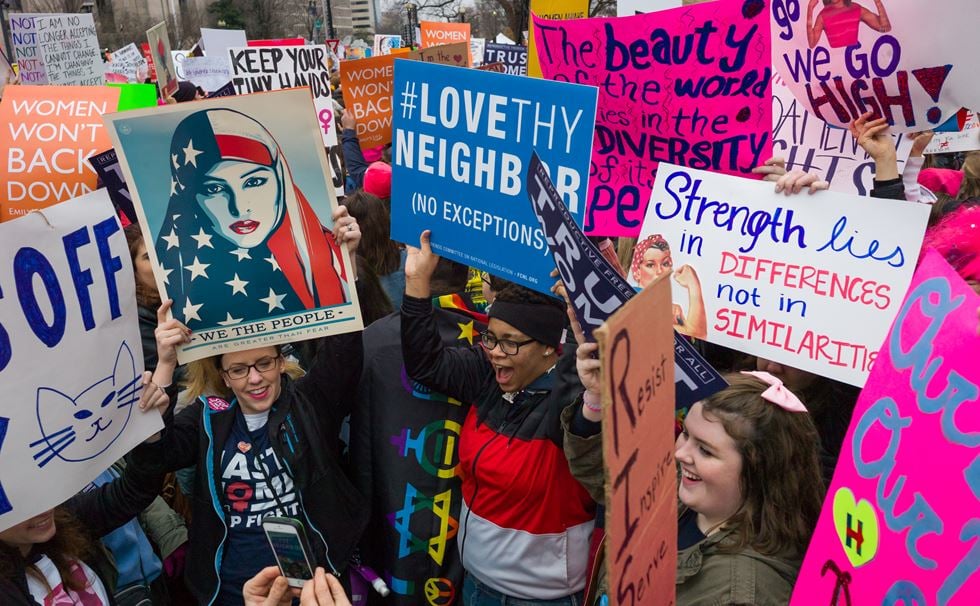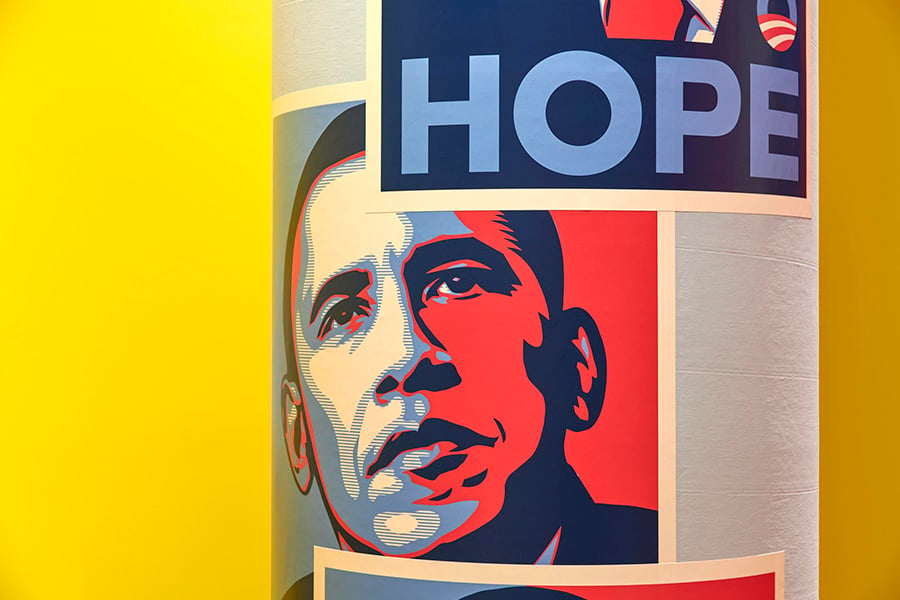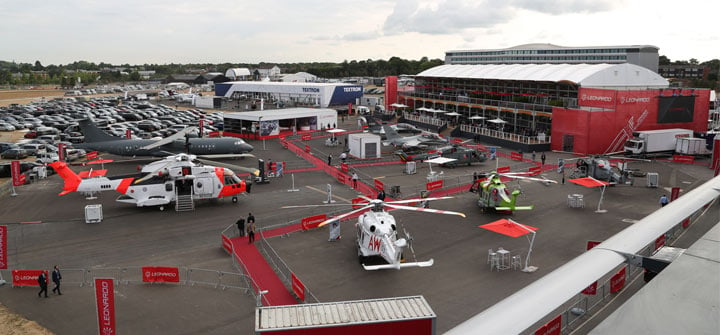Politics
London’s Design Museum Hosted an Arms Dealer—and Now Artists Are Refusing to Show There Anymore
The museum hosted an event for an Italian aerospace company accused of aiding dictatorial regimes.

The museum hosted an event for an Italian aerospace company accused of aiding dictatorial regimes.

Sarah Cascone

The Design Museum in London is facing a firestorm of criticism for hosting a private reception for Italian aerospace company Leonardo on July 17 in conjunction with the Farnborough International Airshow. The Campaign Against Arms Trade has called the airshow an arms fair, and has published an open letter from artists who are demanding the museum remove their work from display by the end of the month.
The museum’s current exhibition “Hope to Nope: Graphics and Politics, 2008–2018” explores the ways in which graphic design has influenced politics over the last ten years, starting with the famed HOPE poster designed by Shepard Fairey for President Barack Obama’s 2008 campaign. The show includes posters and other artworks created for movements such as Occupy Wall Street and Hong Kong’s Umbrella Revolution, as well as Fairey’s “We the People” posters for the 2017 Women’s March.
“It is deeply hypocritical for the museum to display and celebrate the work of radical anti-corporate artists and activists, while quietly supporting and profiting from one of the most destructive and deadly industries in the world,” reads the letter. “‘Hope to Nope’ is making the museum appear progressive and cutting-edge, while its management and trustees are happy to take blood money from arms dealers.”
The signatories include 27 artists and collectives with work currently on view at the institution, as well as six who have participated in exhibition programming.
“I lent objects to the museum which I saved from the 2014 Umbrella Movement protests for democracy in Hong Kong,” Sampson Wong told activist art collective BP or not BP?, who published a blog post explaining their decision to boycott the exhibition. “I am shocked that at the same time as they superficially celebrate our protest materials, the museum is hosting a reception for companies like Chemring, the arms dealers who supplied the tear gas that was used on us.”

Shepard Fairey’s iconic HOPE poster for Barack Obama’s 2008 campaign on view in “Hope to Nope” at the Design Museum, London. Photo courtesy of the Design Museum.
“We are in the process of responding to each contributor regarding the display of their work,” a representative of the Design Museum said in response to an inquiry from artnet News. “The museum is saddened that they may wish to remove their work before the end of the exhibition. It will be a missed opportunity to share the important design stories behind these exhibits.”
According to its website, Leonardo produces commercial and military aircraft and helicopters, satellites, naval artillery, security systems, missiles and missile systems, and other electronics. The Campaign Against Arms Trade claims it is the ninth largest arms company in the world, and has helped enable “human rights abusing regimes and dictatorships.”
Of the 40 planes that flew during the London airshow, the vast majority were commercial vehicles, transport planes, and historic military planes no longer in active military production. A press release touted the sale of over 530 aircraft over the event’s first two days, totaling $95.5 billion in sales, but did not specify what percentage of those were military craft. No details were released about other sales of arms or weapons technology, though Leonardo was showcasing its “maritime security and rescue, intelligence, surveillance & reconnaissance (ISR) and training & light attack,” as well as the AW101 helicopter for the Royal Norwegian Air Force and the P-72A maritime patrol aircraft of the Italian Air Force.

Leonardo’s display area at the Farnborough International Airshow. Photo courtesy of Leonardo.
“As a charity, 98 percent of the museum’s running costs come from admissions, retail, fundraising and event hire, such as the one hosted that night,” the Design Museum told the Guardian, adding that it “is committed to achieving its charitable objective to advance the education of the public in the study of all forms of design and architecture and is thus a place of debate that, by definition, welcomes a plurality of voices and commercial entities. However, we take the response to Tuesday’s event seriously and we are reviewing our due diligence policy related to commercial and fundraising activities.”
The letter calls on the museum to cease accepting funds from arms, tobacco, and fossil fuel companies. Read it in full below.
Dear Design Museum,
We are writing as artists, designers and activists whose work features in your current ‘Hope to Nope’ exhibition, the museum’s permanent collection and on sale in your shop.
Last week, we were appalled to learn that the museum hosted an arms industry trade event as part of the Farnborough International weapons fair. This happened on the evening of Tuesday 17 July, the same time as a discussion about the role of social media and design in contemporary social justice politics as part of the Hope to Nope season of events.
It is deeply hypocritical for the museum to display and celebrate the work of radical anti-corporate artists and activists, while quietly supporting and profiting from one of the most destructive and deadly industries in the world. Hope to Nope is making the museum appear progressive and cutting-edge, while its management and trustees are happy to take blood money from arms dealers.
We refuse to allow our art to be used in this way. Particularly jarring is the fact that one of the objects on display (the BP logo Shakespeare ruff from BP or not BP?) is explicitly challenging the unethical funding of art and culture. Meanwhile, many of the protest images featured in the exhibition show people resisting the very same repressive regimes who are being armed by companies involved in the Farnborough arms fair. It even features art from protests which were repressed using UK-made weapons.
We therefore request that our artwork be immediately removed from the exhibition. The specific pieces are listed below. We will not associate our names and our work with an institution that actively supports the arms industry. This request is also backed by speakers and other contributors to Hope to Nope and its related events.
Following some private communications with senior museum staff, we now believe it is important to make this request publicly. The ethics of our national museums is a significant issue of public interest, and other artists and designers whose work features in the Design Museum also have a right to know that the gallery where their work is displayed is being rented out to arms dealers.
In your communications with us and others so far, you have not adequately engaged with our concerns. Instead, you have sought to avoid responsibility for the decision to host a weapons fair event, calling it a ‘private event for which there is no endorsement by the museum’. But by hosting an event for – and taking money from – an industry that many other arts institutions quite rightly see as beyond an ethical red line, you have made a very clear statement that you do not share these concerns and are happy to let war profiteers use your spaces if the price is right.
Museums are not neutral spaces – every decision about what is displayed, how it is labelled and how it is funded is political, and reveals something about the underlying values of the institution. By hosting an arms industry event, the Design Museum is presenting values that are strongly at odds with most of the art in Hope to Nope, which aspires to use the power of design to challenge powerful elites and promote peace and justice.
We want to make it clear that our criticism is directed at the management and trustees of the Design Museum, not the curators who have created a fantastic showcase of radical art and had no say in the arms fair booking. We were all proud to be included in Hope to Nope, and do not take this action lightly.
The museum could avoid these controversies in future by developing a publicly-available ethical funding policy that specifically refuses any funds from industries widely accepted as inappropriate partners for arts organisations, namely arms, tobacco and fossil fuel companies. Once this is in place, we would consider working with the museum again.
Please confirm that our work will be taken down by August 1st at the latest, as our art is now being displayed in your museum without our consent.
Signatories (people with specific art in the exhibition, permanent collection and on sale in the shop)
BP or not BP? and Stig, designer (BP ruff)
Pavel Arsenev, Laboratory of poetical actionism (‘You cannot even imagine us’ banner)
Roman Osminkin, poet, artist, activist, St Petersburg Russia (‘You cannot even imagine us’ banner)
Kathrin Böhm, co-founder of Company Drinks (6 bottles of Sour Brexit)
Keep it Complex, Make it Clear arts collective (Unite Against Dividers campaign material)
Peter Marcuse and Bill Posters, Brandalism Collective (subverted adverts)
James Moulding and Dr Richard Barbrook, Games for the Many (Corbyn Run)
Fraser Muggeridge (Spectres of Modernism installation)
Noel Douglas, Occupy Design Collective (Occupy Design website and materials)
Kiran Chahal and Stephanie Turner (Co-Designers of Grenfell ‘Wall of Truth’ – ‘The Truth Will Not Be Hidden’)
Paolo Pedercini, Molleindustria, (“Casual Games for Protesters”)
Jonathan Barnbrook (Brandalism VW poster)
The Space Hijackers (Official Olympics Protestor t-shirt)
Charlie Waterhouse and Clive Russell, This Ain’t Rock’n’Roll (Brixtopia & The Brixton Pound)
Peter Kennard (‘Union Mask’ in the permanent collection display ‘Designer User Maker’ – donated to Design Museum)
Occupy London (campaign materials and copies of Occupied Times)
Benny Tai, one of the initiators of the Occupy Central with Love and Peace Movement and a core participant of the Umbrella Movement in Hong Kong
Sampson Wong (Umbrella Movement Visual Archive)
Sarah Corbett, Craftivist Collective (Mini Banner craftivism DIY kits, in museum shop)
Jamie, Bristol Streetwear (Corbyn T-shirt with Nike swoosh)
Tim Fishlock, Oddly Head (Slogans in Nice Typefaces Won’t Save the Human Races poster)
dr.d (Curfew Social Cleansing poster)
Matt Huynh (Occupied Wall Street Journal cover)
Malu Halasa (author, Syria Speaks: Art and Culture From the Frontline)
Shelley Hoffman (Black Lives Matter quilt)
Supporters (people who have participated in events relating to the exhibition)
Ash Sarkar (editor, writer, lecturer)
Gavin Grindon (curator, Disobedient Objects, Victoria & Albert Museum)
Catherine Flood (curator, Disobedient Objects, Victoria & Albert Museum)
Matt Bonner (designer)
Mel Evans (author, Artwash: Big Oil and the Arts)
Michael Oswell (Studio Accelorata Jengold)
Joshua Wong (Umbrella Movement, Hong Kong)
UPDATE, JULY 27: A representative for the museum emailed artnet News with a statement indicating that they plan to review their policies regarding hosting private events and its other commercial activities, based on the concerns of the protesting artists. While the review is underway, they will not host events for companies in the arms, tobacco, or fossil fuel industries. The museum hopes that the protesting artists will therefore agree to keep their work on view through the exhibition’s end on August 12.
Our existing fundraising policies are in line with those of our peers in the museum sector. Last week’s commercial hire of the museum that some exhibitors objected to was a private party. It formed no part of the museum’s program or had any endorsement from the museum. Having listened to the concerns of those exhibitors, the Design Museum is undertaking a thorough review of its policies and is extending it to its commercial activities.
We have entered a dialogue in the hope of ensuring that the exhibits remain in place until the exhibition closes to the public on August 12, to make sure as many people as possible have the opportunity to see the variety of work on display. In light of this, we are committing not to have any private event hires from defense, fossil fuels and tobacco companies while we undertake our policy review.
“Hope to Nope: Graphics and Politics, 2008–2018” is on view at the Design Museum, 224-238 Kensington High Street, London, through August 12, 2018.